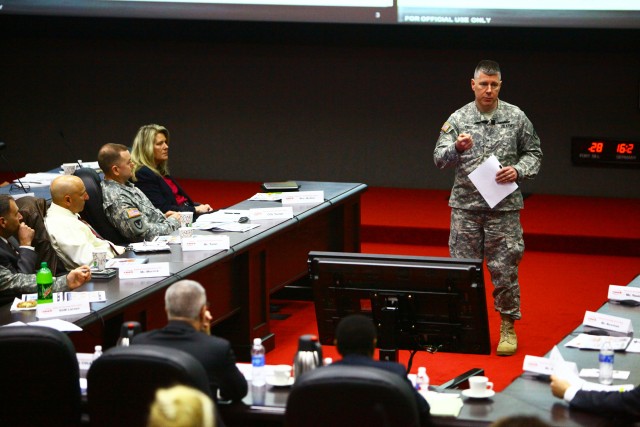
FORT SILL, Okla. (March 19, 2015) -- Army leaders and researchers met at Fort Sill to discuss the Soldier force and the technologies needed to fight in the fires battlefield in the year 2040 and beyond.
More than 80 Soldiers and Civilians participated in the Science and Technology Home on Home Seminar March 11-12 at Snow Hall. They came from the Fires Center of Excellence, or FCoE; Army Research, Development and Engineering, or RDE, Command; Tank Automotive RDE Center; Armament RDE Center; and Aviation and Missile RDE Center.
The annual seminar allows capabilities' directors to communicate with the science and technology community so they can understand the FCoE commanding general's vision, said seminar host Col. Gregory Dewitt, FCoE Capabilities Development and Integration Directorate, or CDID, director.
"We're really looking far down the road, and to begin that dialogue about technologies and capabilities that we may see in the future," Dewitt said.
One of the goals of the seminar was to reinforce FCoE and Fort Sill Commanding General Maj. Gen. John Rossi's vision of a one-one-one strategy, Dewitt said.
The one-one-one strategy looked at a one fires mission command, one fires sensor and one fires shooter.
Attendees discussed the potential desired capabilities of a one mission command, Dewitt said.
The one tactical sensor for counterfire and air surveillance would replace the three radars currently used: Q50 and Q53 for field artillery, and the Q64 for air defense artillery, the colonel said. If one tactical sensor is not feasible, then a set of tailorable systems might be used.
The one tactical shooter weapon might not necessarily be a gun, Dewitt said.
"When were talk about the future, it might be a weapon that can perform both an FA and ADA role," he said.
There are four tenets to the one-one-one-strategy, the colonel said.
- Commonality, or how similar systems can be. Dewitt used the analogy of a GMC Yukon compared to a Chevrolet Tahoe. Both are SUVs, but are two different vehicles that share commonalities.
"If I can't have one [kind of system] how much commonality can I have," he said.
- Expeditionary, which is the combination of deployablity and mobility to support unified land operations.
- Material solutions must work within the network, and fires capabilities must be integrated and maximized through data sharing.
- Optimal force structure, or how many Soldiers are needed on a fires operator system.
At the conclusion of the seminar integrated product teams were created "to discuss what is in the realm of possible for the future," the CDID director said.
The seminar was very well received, Dewitt said.
"We narrowed our focus talking mission command and tactical sensors and shooters," he said. "I received a lot of positive feedback."

Social Sharing